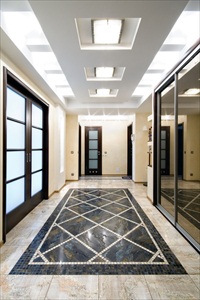Cleaning Tile Floors
A walk through the ages
The Beginning
In the beginning, Cleaning Tile Floors was as simple as throwing a bucket of water down and using a broom, pushing the dirt outside.
Let’s take a walk back in time to the beginning of the story.
They were developed over the centuries from pottery.
In medieval times a lead based glaze was applied and when fired became very hard. With a clear surface that would protect them from any absorption.
This made them very strong. And waterproof and that meant you could use them on the floors. As time went by patterns were set into the tiles and then refried to set them.
The cost was so high that
only the wealthy could afford Installing Tile Floor.
They were used in churches, institutions, and estates with the means. Colors were added later and even designs to make pictures out of.
Eventually they were used on walls for insulation.
We still use them for flooring and walls and even use them behind cook-tops with patterns on them or tiles that make a picture.
In the 17th century the Dutch in the town of Delft came up with their own version of porcelain.
The Chinese had made porcelain for years but
no one could duplicate the process, the Dutch in time came up with their own
version of tile fired with the famous blue color we all know as Delft.
Cleaning Tile Floors: there are three kinds of tile.
Ceramic:
- Made from clay, shale, gypsum, and sand. Then fire
Quarry:
- cut right from a quarry and then polished and sealed. However today it is extruded and made very hard from firing.
Stone:
- is the choice today for most kitchens and baths. Although very pours if sealed and kept up will retain it's beauty. But used on counter tops it must be sealed and polished at all times.
Cleaning Tile Floors: How do we keep them clean.
Ceramic:
- Sweep or vacuum the area.
- Then fill a bucket with some warm water and some vinegar.
- Add your micro cloth, take your knee pad and get down on the floor and start to wash. Take a small area and using a brush go over the area and then let sit for a few minutes.
- Go over again with the brush then rinse off and wipe down.If you need to dry take a dry towel and go over the area.. If your ceramic is patterned, then this will need to be done more often.
- If you have high traffic areas you can use rugs to protect them and help
keep the dirt down. Learn about Cleaning Tile Grout here.
- Of course there are many products on the market today for Cleaning Tile Floors, and we are always tempted to try them out, but keep it simple and it will always stay clean.
Quarry:
- Vacuuming with a brush attachment is a good idea.
- Quarry can be very pours so you don’t want to scratch the surface with brooms.
- It can also hold dust very well.
- A bucket of warm water and a cleaner like Bio Green Clean.It’s a plant based product filled with all of those enzymes you need to clean with. A totally green cleaner.
- If you must rinse after then use just warm water and then dry with a clean towel.
Stone:
- you will want to vacuum your stone floors, of course stay away from the beater bars because they can cause damage to your floors. If you drop something wipe it up immediately. Going over your stone floors with a damp mop will help to keep them clean. Use a low ph level cleaner on your stone.
- Others can leave a film that then needs to be removed.
- I find that filling a bucket with warm water and some low ph level cleanerdoes the job fine. Use your knee pad and get down on the floor and go over it with your cleaner and be sure to wipe and dry as you go. High traffic areas can be covered with rugs to protect them from spills and shoe traffic.
- You will get a long life out of your stone floors if you keep them up.
Useful Resources :
There are many different ways of cleaning all different types of tile and grout, not to mention natural stone flooring like travertine tile, etc. Here's a thorough but quick reference page you'll find handy.
house cleaning guide / contact us / legal disclaimer / privacy policy /site map /









